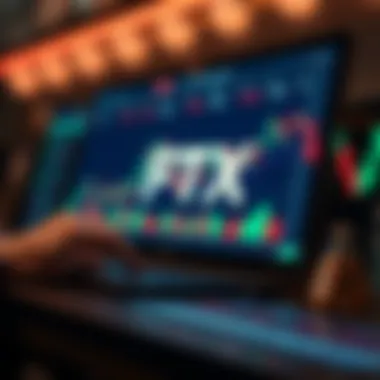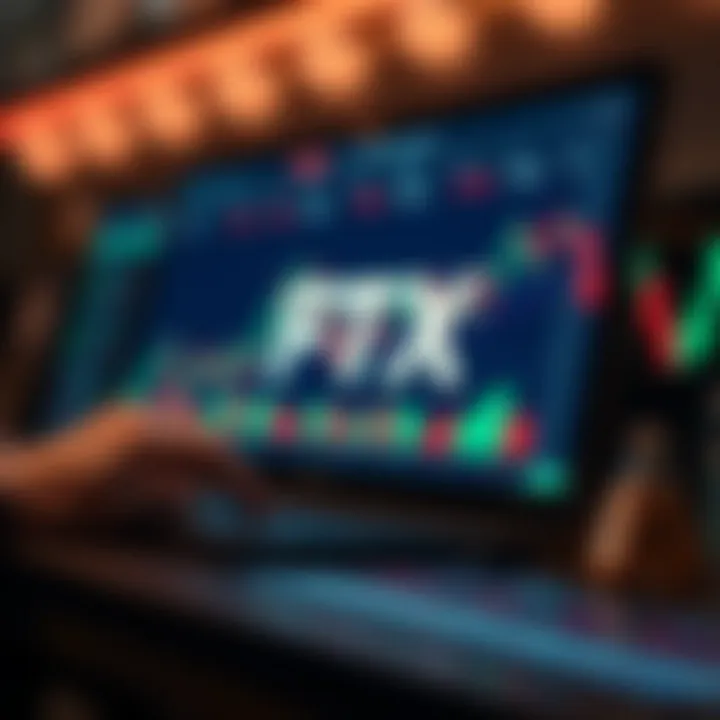Understanding FTX Crypto Fees for Smart Trading


Intro
Navigating the choppy waters of cryptocurrency can feel like trying to catch smoke with your bare hands. Among the many aspects traders and investors must grapple with, understanding the fee structures of exchanges like FTX is paramount. This not only affects the profitability of individual trades but also shapes overarching trading strategies. As the landscape of cryptocurrency trading evolves, the implications of these fees resonate through market mechanics and investor decisions alike.
FTX has carved out a reputation not just for its innovative trading options but also for its approach to fees. A smorgasbord of different charges can catch even the most seasoned traders off guard. Thus, having a clear grasp of how these fees are structured and how they interweave with trading patterns is essential. With so much at stake, let’s dive deeper into the nuances of FTX crypto fees and how they compare to other platforms in the digital currency universe.
Crypto Insights
Understanding Market Trends
In the world of cryptocurrencies, market trends can shift faster than the flick of a switch. Understanding these trends is closely linked to how fees can influence buying and selling decisions. Traders often need to act quickly, and high fees can dampen their enthusiasm. If you're shelling out a chunk of your potential profit on fees, it might be wise to reconsider your trading frequency and strategy.
Many new investors might overlook this critical aspect, thinking fees are merely a background noise. Yet, these fees can amplify during periods of market volatility. Knowing when to enter or exit a position while keeping fees in mind can make all the difference. For instance, in the wake of significant price swings, an unexpected surge or drop in volume can also lead to varying fees, especially in a tiered structure.
Analyzing Price Fluctuations
Price fluctuations are the lifeblood of trading, and fees can significantly alter how investors respond to these changes. The structure of FTX fees, for instance, is often influenced by the type of trade being executed—be it a spot trade, futures contract, or leveraged tokens. Hence, knowing this framework is crucial to maximizing gains.
For those dabbling in more obscure altcoins, the liquidity—or lack thereof—can also play a role in fees incurred during trades. Higher market impact typically leads to higher fees, which can considerably skew profit margins. Paying close attention to how these dynamics unfold in the market can arm investors with the strategies they need to utilize FTX's fee structures to their advantage.
"The devil is in the details; knowing your fees can save you a pretty penny in the long run."
Educational Resources
Beginner's Guides to Cryptocurrency
For novices stepping into the crypto arena, building a solid foundation is non-negotiable. Consider checking out resources like Investopedia, which offers a wealth of articles on basic terminologies and practices in cryptocurrency.
Additionally, platforms like Coinbase Learn provide beginner-friendly insights, laying the groundwork for understanding not just trading but the intricacies of fees as well. Understanding the basics is like laying a strong foundation for a house—without it, everything crumbles.
Advanced Blockchain Concepts
For seasoned investors looking to refine their strategies, exploring advanced concepts in blockchain can offer an edge. Websites like blockchain.com and findlaw.com dive into complex topics such as decentralized finance (DeFi) and smart contracts, shaping the future of trading. This knowledge can also be instrumental when evaluating the cost-effectiveness of trades and choosing the right trading platform, like FTX, based on their fee structures.
As traders continue on their journeys, understanding these educational resources can illuminate pathways to leverage market conditions, optimize fees, and capitalize on opportunities without falling prey to costly traps. Let's keep the learning curve steep and the trading savvy sharper.
Preface to FTX Crypto Fees
Understanding the specifics of FTX crypto fees is more than just a passing interest for traders; it’s essential for anyone serious about navigating the cryptocurrency market. With numerous exchanges available, the cost structure can greatly impact profitability. FTX, being one of the major players in the arena, has a fee structure that intricately combines various elements—trading fees, withdrawal fees, and other costs, each designed to cater to different trading habits.
Understanding the Basics
To get a good grasp on FTX crypto fees, we first need to break down the fundamentals. These fees are essentially the costs associated with using the platform for trading and transactions. At FTX, there are several types of fees, which can be grouped into a few key categories:
- Trading Fees: Charges incurred when executing buy or sell orders.
- Withdrawal Fees: Costs associated with transferring funds out of the platform.
- Deposit Fees: Some transactions might come with their own fees when putting money into the exchange.
Diving deeper, trading fees on FTX are typically expressed as a percentage of the transaction volume. The distinction between maker and taker fees is particularly important. This classification determines how the fee is applied depending on whether a trader provides liquidity to the market (maker) or takes liquidity away (taker).
Importance of Fee Structures
The significance of understanding these fee structures cannot be understated. For investors operating in an environment where margins can be thin, every penny counts. Knowing how fees impact your total cost allows traders to:
- Develop Better Strategies: By understanding when fees are lower and designing trades around those times, investors can maximize returns.
- Choose the Right Exchange: With many options out there, being aware of how FTX’s fees compare helps in making informed decisions.
- Optimize Trading Behavior: Understanding how to manipulate one’s trading pattern in accordance with fee structures can lead to more effective and profitable trading sessions.
"In the world of crypto, managing costs is just as crucial as securing gains. Ignoring the fee structure is like sailing a ship without checking for leaks."
In essence, a thorough grasp of FTX's crypto fees equips both new and seasoned investors with the knowledge to navigate trading strategies that can lead to long-term success. By acknowledging how every trade and transaction shape up financially, users can engage more thoughtfully in the bustling crypto ecosystem.


An Overview of FTX
Understanding the dynamics of FTX is crucial for any participant in the cryptocurrency market. The platform has swiftly established itself as a pillar in the crypto trading arena, facilitating a broad spectrum of transactions for both novice and seasoned traders. With the landscape constantly evolving, it is pertinent to grasp the foundational aspects of FTX, as well as the unique features it provides. This section will unravel these fundamental elements, shedding light on why FTX has become an appealing choice for many.
Platform Background
FTX was founded in 2017 by Sam Bankman-Fried and Gary Wang. This exchange emerged from a profound necessity within the crypto environment to offer advanced trading options in addition to basic services. The founders, inspired by their own frustrations with existing platforms, aimed to create a more user-friendly and feature-rich trading experience. Since its inception, FTX has attracted considerable attention and investment, augmenting its offerings while ensuring a stable platform for trading various digital assets.
Unlike many exchanges that started off with limited capabilities, FTX incorporated sophisticated products such as futures, options, and tokenized stocks almost from the get-go. The exchange is regulated and operates with a focus on transparency and security — factors that are often overlooked in crypto discussions. FTX also embraced innovative features like prediction markets, which allow users to trade on the outcomes of events, further distinguishing it from competitors. Overall, the background of FTX is not just a story of growth, but also one of resilience in a fluctuating industry.
Key Features
FTX offers a plethora of features that enhance user experiences and facilitate a journey through the cryptocurrency space. Understanding these features can provide insight into how to leverage the platform effectively. Here are several defining characteristics:
- Diverse Product Range: FTX doesn’t just cater to simple spot trading; it offers futures contracts, options, prediction markets, and leveraged tokens, thereby accommodating a wide variety of trading strategies.
- User-Friendly Interface: The platform has been designed with both novice and experienced traders in mind, boasting an intuitive UI that makes navigation seamless, along with detailed analytics for informed decision-making.
- Advanced Order Types: Users can access unique order types, such as stop orders and trailing stops, allowing for more strategic trading maneuvers that can mitigate risks.
- Strong Liquidity: FTX ensures robust liquidity, which is essential for executing large orders without significantly impacting the market price. This aspect is pivotal in trading where timing is everything.
- Educational Resources: The exchange places significant emphasis on educating its user base, offering a range of resources from tutorials to market analysis to help traders make informed decisions.
Effective use of FTX's offerings can turn the tide for many traders, empowering them to better navigate the complexities of the crypto world.
As markets shift and new opportunities arise, having a solid foundation and understanding of platforms like FTX will empower users to make calculated and informed trading decisions.
Types of Fees on FTX
Understanding the various types of fees on FTX is crucial for anyone navigating the world of cryptocurrency trading. Each fee serves a distinct purpose and can significantly influence the overall trading experience. Knowing how these fees operate allows traders to not only strategize their investments but also maximize their potential earnings. The types of fees imposed can vary based on the trading volume, the specific assets involved, and the chosen strategies regarding withdrawal and deposit options. Thus, this section aims to break down the various fees associated with the FTX platform, illustrating the implications for traders.
Trading Fees Explained
Trading fees on FTX are the charges that apply when buying or selling cryptocurrencies on the platform. This fee structure is usually categorized into maker and taker fees.
- Maker Fees are applied to orders that add liquidity to the market. When a user places a limit order that isn't immediately matched with an existing order, they are considered a maker.
- Taker Fees, on the other hand, are charged when an order takes liquidity away from the market. This happens when a trader places a market order that immediately matches an existing order.
The fees can differ based on several factors, including the trader's volume within a set period. For example, high-volume traders tend to benefit from reduced fees due to their contribution to overall liquidity on the exchange.
Withdrawal Fees
Withdrawal fees are associated with moving cryptocurrency from your FTX account to an external wallet. This fee varies depending on the specific cryptocurrency being withdrawn. For instance, withdrawing Bitcoin may incur a different fee than withdrawing Ethereum.
It's important to note that these fees can fluctuate with network conditions. During periods of high transaction volume on the Bitcoin network, for instance, withdrawal fees can be higher than normal. Therefore, timing can play a crucial role in minimizing these costs.
Deposit Fees
When depositing funds into an FTX account, traders often find no fees for most cryptocurrencies; however, some specific types could incur charges. This is mostly due to the network's transaction fees, applicable during the deposit process.
As of now, FTX does not impose deposit fees for typical operations with fiat currency but always check for updates as exchange policies can change.
Margin Trading Fees
Trading on margin involves borrowing funds to trade larger positions than your account balance would otherwise allow. On FTX, margin trading fees come into play when utilizing leverage. The interest on borrowed funds is charged whether you gain or lose, and the rate can vary based on the cryptocurrency being traded.
It is also worth noting that the fees associated with margin trading can create a drag on profitability, especially in volatile markets. Thus, a clear understanding of these fees is essential for margin traders to make informed decisions.
Stablecoin Fees
Stablecoins, designed to maintain a stable value against fiat currencies, are increasingly popular among traders and investors. On FTX, deposits and withdrawals using stablecoins can attract lower fees due to their widespread use and lower transaction costs compared to more volatile cryptocurrencies. Furthermore, stablecoins are often used in trading pairs, offering liquidity benefits.
In summary, understanding the types of fees associated with FTX is essential for anyone aspiring to trade on the platform. By knowing what fees to expect, traders can make strategic decisions that enhance their trading experience and bolster their investment outcomes.
Detailed Examination of Trading Fees
Understanding the various trading fees at FTX is essential for optimizing your investment strategy. Trading fees can significantly affect your overall profitability. Grasping the different layers of these fees enables investors to make more informed decisions and better manage their trading costs. On FTX, the fee structure is designed to cater to a wide range of traders, from newcomers to seasoned experts, making it crucial to unpack the fine details of how these fees operate.


Fee Tiers
The concept of fee tiers is a fundamental aspect of the trading landscape on the FTX platform. FTX employs a tiered fee structure, meaning the fees you pay depend on your trading volume over a certain period. The more you trade, the lower your fees can become. This means that frequent traders might find themselves in a position to significantly reduce their costs.
For example, if you are a trader who executes multiple transactions during the month, you could start at a higher fee tier but, with consistent trading, drop down to a lower tier where fees might be halved or more.
This incentivizes active trading, rewarding users for their engagement and boosting their overall trading experience.
Maker vs. Taker Fees
Trading on FTX distinguishes between makers and takers, each attracting different fees. Makers, those who provide liquidity by placing limit orders, often enjoy lower fees. Takers, on the other hand, are users who take liquidity by executing orders at market prices. This differentiation is pivotal; it encourages users to place orders that contribute to the market depth, fostering a more balanced and efficient trading environment.
Think of it this way: when you place a limit order, you’re adding to the pool of available liquidity, similar to a well-fish stocked pond. However, when you execute a market order, you are directly consuming that liquidity. As a result, makers often enjoy lower fees than takers, serving as an incentive for users to become liquidity providers.
Volume-Based Discounts
FTX also offers volume-based discounts, which means traders with higher monthly trading volumes can avail themselves of reduced fees. This concept operates on a straightforward premise; as you engage more with the platform, your trading costs decrease. This can be especially advantageous in the volatile crypto market where trading frequency might escalate.
Tailoring strategies around these volume-based discounts can enhance cost-effectiveness. The savings accrued over multiple trades can add up quickly, leading to a more profitable trading experience. As such, it’s vital for traders to keep an eye on their monthly trading volume, not just for commission savings but also for broader strategic planning in their trading endeavors.
In summary, the intricate nature of trading fees on FTX isn’t just about numbers on a page; it’s about how those numbers can affect your bottom line. Understanding fee tiers, the differences between maker and taker fees, and taking advantage of volume-based discounts can greatly influence your trading success in the fast-paced world of cryptocurrency.
Comparison with Other Exchanges
When diving into the world of cryptocurrency trading, understanding how FTX stacks up against its competitors is crucial. Fees can vary greatly from one exchange to another, and knowing the landscape helps traders make informed decisions. A well-structured fee system can significantly impact the profitability of your trading activities and ultimately affect your entire investment strategy.
Comparing FTX's fees with other exchanges like Binance and Coinbase helps illuminate the advantages or drawbacks of each platform. When traders assess these comparisons, they diversify their choices effectively, often leading to better trading outcomes. Key elements to consider include not only the fee structures themselves but also how these fees translate into your trading experience. Here, we delve into how FTX holds its ground next to Binance and Coinbase, two significant players in the crypto exchange arena.
FTX vs. Binance
FTX and Binance are like the heavyweight champions in the crypto exchange world, each boasting unique selling points. While Binance had established a reputation for being vast and varied, FTX carved its name with a focus on user experience and an expansive array of derivatives.
Fee Comparison:
- Trading Fees: FTX’s trading fees generally range from 0.02% to 0.07% for makers and takers. On the other hand, Binance charges between 0.1% and 0.2%.
- Withdrawal Fees: FTX stands out, typically offering competitive withdrawal fees compared to Binance, especially for various altcoins.
Both platforms provide tiered fee structures, which means fees can drop further based on trading volume. As such, high-frequency traders may lean towards FTX due to its tailored offering for frequent buyers. However, it's essential to verify if different cryptocurrencies have variable fees across exchanges.
FTX vs. Coinbase
Shifting focus to Coinbase, known for its simplicity and beginner-friendly interface. While it's a favorite for novice traders, its fee structure can be a bit overwhelming due to various layers. Coinbase implements a base fee combined with a percentage of the transaction, often leading to higher costs compared to FTX.
Fee Breakdown:
- Trading Fees: On Coinbase, users might face anywhere from 0.5% to 4.5%, based on the transaction size. FTX, with its transparent fee model, doesn't have such variability, making it easier for traders to calculate costs upfront.
- Withdrawal Fees: Generally, FTX is more advantageous in this domain as well. Withdrawal fees on Coinbase can spike, especially when linked to bank account transfers.
This comparison illustrates the stark differences. Users seeking clarity in fees and efficiency in trading often find FTX to be a more favorable option compared to Coinbase, which may bury users in fees depending on their trading habits.
Fee Structures Analyzed
In dissecting fee structures across FTX, Binance, and Coinbase, we uncover a wealth of insights that go beyond mere numbers. Here are some key considerations:
- Transparency: FTX excels in this area, offering clear descriptions of all fees involved. Binance and Coinbase may sometimes require digging to fully understand fee implications.
- Volume-Based Discounts: All three exchanges offer discounts for high-volume traders. However, FTX’s structure is designed to benefit frequent market participants more directly.
- Implications of Fees: Fees don't just impact immediate trades. They shape long-term strategies, particularly for traders concerned with profit margins. A higher fee might dissuade traders from making frequent smaller trades, guiding them toward larger investments instead.
Important Note: Always consider the total cost of trading by factoring in deposit and withdrawal fees alongside trading fees.
Strategies for Managing Fees
Understanding how to manage fees on the FTX platform is essential for maximizing your trading potential and protecting your investments. Crypto trading can be a volatile game, and every cent can add up significantly over time. Fees, whether they be trading, withdrawal, or deposit-related, often feel like nagging little gremlins gnawing at your profits. By honing strategies to manage these costs, traders can turn the tide in their favor. Here, we’ll explore two potent strategies you can integrate into your trading game plan.


Optimal Trading Times
Timing isn’t just everything in life; it can also be the difference between a profitable trade and a loss when it comes to crypto fees. In the hustle and bustle of trading, identifying optimal trading times can lead to significant savings. Each exchange, including FTX, may have fluctuating fees based on market activity. When trading volumes are low, for instance, fees might plummet.
To leverage this, consider the following:
- Monitor peak trading hours: Typically, weekends or late at night in quieter markets can see reduced trading activity. Engaging during these times could save you a bit on fees.
- Set up alerts: Use FTX’s features to notify you when trading fees drop below a certain threshold. If you're not glued to your screen, this ensures you won't miss out.
By paying attention to market rhythms, traders can strategically position their transactions to sidestep higher fees and make their strategies more efficient.
Use of Fee Discounts
FTX offers several strategies individuals can pursue to reduce their trading costs. One effective method is to take advantage of fee discounts, which can provide significant savings over time. These discounts can arise from various sources such as loyalty programs or using the FTT token, FTX's native cryptocurrency. Here’s how you can broaden your knowledge of discounts:
- Loyalty Levels: FTX has fee tiers based on trading volume; the more you trade, the lesser the fees. Consider ramping up your trading if you’re nearing a threshold that could lower your costs.
- Utilizing the FTT token: Holding and using FTT tokens can lead to reduced fees. Users who stake FTT can enjoy fee discounts as part of the loyalty program – a win-win for those already vested in the platform.
By combining volume assessments with engagement in loyalty programs, traders may see their fees shrink, translating into more substantial profits over time. It might make sense to keep an eye on the fine details and jump at opportunities to reduce operating costs, allowing a bigger slice of the profit pie.
"Managing fees wisely is akin to treating your investments as a garden—you need to prune away unnecessary expenses to foster growth."
These strategies are not just about saving money; they embody the very ethos of smart trading. By understanding and implementing these methods, you position yourself for more profitable outcomes. Maximizing your approach to fee management is not just practical—it’s critical.
Future of Fees in Crypto Trading
The landscape of cryptocurrency trading is ever-evolving, and understanding the future of fees in this domain can help traders make better decisions. As cryptocurrencies gain more traction, the dynamics of fee structures are also likely to shift towards greater transparency and adaptability. This section seeks to address crucial aspects that come into play when considering future fee structures on platforms like FTX.
One significant factor shaping this future is increased competition among exchanges. With new players entering the market, established exchanges must continually reevaluate their fee models to remain attractive. Fee wars, where exchanges cut rates to capture market share, could lead to significantly lower trading costs for users. Therefore, savvy investors should stay informed about evolving fee structures as exchanges respond to competitive pressures.
Additionally, user preferences can drive changes in fees. Traders often look for platforms that provide better value not just through lower fees, but through enhanced services. For example, if an exchange offers superior tools, analytics, or educational resources, a trader might be willing to accept slightly higher fees for that additional value. Understanding these preferences is paramount for exchanges to strike a balance between fees and overall user satisfaction.
Another consideration is technological advancements. The rise of automation and advancements in blockchain technology might influence how fees are calculated and collected. Potential developments include the use of smart contracts to automate fee deductions seamlessly or to implement real-time fee adjustments based on network conditions. The integration of machine learning to analyze user behaviors and optimize fee structures could also become a norm in the future.
Ultimately, awareness of these trends can empower traders to adapt their strategies accordingly. Keeping an eye on the competitive landscape, technological innovations, and shifts in user expectations may furnish traders with a distinct advantage in managing costs effectively.
Trends in Fee Structures
To delve deeper, let’s explore some trends that are likely to shape the fee structures in cryptocurrency exchanges such as FTX.
- Dynamic Fee Models: As more exchanges adopt fluid pricing strategies based on market conditions, fee structures could become more responsive. This may mean varying fees depending on trading volume or time of day.
- Loyalty Programs: To retain users, exchanges might introduce incentive programs where users can accrue rewards that offset trading fees. The more a user trades or holds specific tokens, the lower their fees may become.
- Flat vs. Tiered Fees: While some platforms offer flat fees for transactions, others might increasingly adopt tiered systems based on user levels or volumes. The choice between these models will largely depend on user demand and trading behavior.
Impact of Regulations
Regulatory changes can have profound effects on fee structures in the crypto industry. As governments and financial authorities around the world work to establish frameworks for cryptocurrency, several elements are crucial to consider:
- Transparency Requirements: Regulators may impose stricter rules for exchanges to disclose their fee structures clearly. This could lead to a more informed trading population, enabling users to make comparisons and choose platforms wisely.
- Enhanced Security Measures: New regulations may also necessitate changes in compliance fees. Exchanges that prioritize security and regulatory compliance could pass on those costs to users, affecting trading fees.
- Cross-Border Trading: Global regulations can dictate how exchanges operate across borders, potentially altering fee structures based on jurisdictional requirements. This situation would necessitate a deeper understanding from traders about international fees and regulations that apply to their trades.
The End
Understanding the ins and outs of FTX crypto fees is crucial for anyone engaged in cryptocurrency trading, be they newcomers or seasoned investors. This section not only wraps up our exploration of the various fees associated with FTX but also shines a light on how these fees can drastically influence trading strategies and investment decisions.
Summary of Key Insights
To sum it up, here are some pivotal takeaways regarding FTX fees:
- Diverse Fee Structures: From trading to withdrawal fees, FTX presents a multifaceted fee system that any trader must grasp.
- Fee Comparison: Evaluating FTX's fees against competitors like Binance or Coinbase emphasizes the importance of selecting the right exchange for your trading style.
- Cost Management: Implementing strategies such as trading during optimal hours or capitalizing on fee discounts can significantly reduce expenses.
By comprehensively understanding these points, traders can make informed decisions that ultimately enhance their investment outcomes.
Final Thoughts
As cryptocurrency continues to gain traction among investors worldwide, being well-acquainted with the fee structures of platforms like FTX is of paramount importance. It’s not just about understanding how fees work; it's about foreseeing how they can affect profits and losses in the volatile market.
Looking ahead, the world of crypto trading is sure to evolve, and so will the fee landscapes of exchanges. Thus, keeping up with these changes is key. As a community of crypto enthusiasts, investors, and developers, fostering knowledge around such intricate aspects of trading is essential for maximizing investments and navigating the unpredictable waters of blockchain technology.
Knowledge of fees isn’t just a nice-to-have; it’s integral to becoming a savvy trader in the world of crypto.



